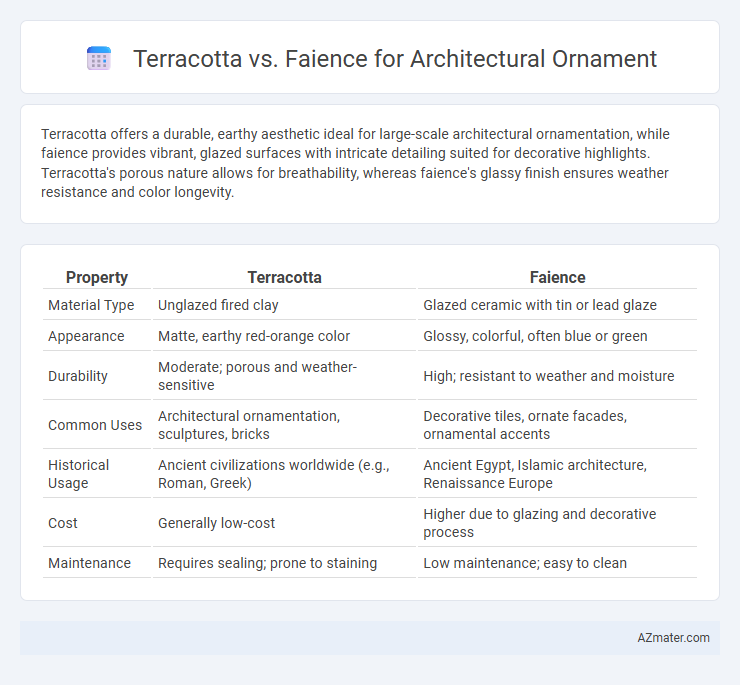Terracotta offers a durable, earthy aesthetic ideal for large-scale architectural ornamentation, while faience provides vibrant, glazed surfaces with intricate detailing suited for decorative highlights. Terracotta's porous nature allows for breathability, whereas faience's glassy finish ensures weather resistance and color longevity.
Table of Comparison
| Property | Terracotta | Faience |
|---|---|---|
| Material Type | Unglazed fired clay | Glazed ceramic with tin or lead glaze |
| Appearance | Matte, earthy red-orange color | Glossy, colorful, often blue or green |
| Durability | Moderate; porous and weather-sensitive | High; resistant to weather and moisture |
| Common Uses | Architectural ornamentation, sculptures, bricks | Decorative tiles, ornate facades, ornamental accents |
| Historical Usage | Ancient civilizations worldwide (e.g., Roman, Greek) | Ancient Egypt, Islamic architecture, Renaissance Europe |
| Cost | Generally low-cost | Higher due to glazing and decorative process |
| Maintenance | Requires sealing; prone to staining | Low maintenance; easy to clean |
Introduction to Architectural Ornamentation
Terracotta and faience serve as prominent materials in architectural ornamentation, each offering distinct aesthetic and structural qualities. Terracotta, a clay-based ceramic, is favored for its durability, versatility, and warm, earthy tones, making it ideal for intricate moldings and facade decorations. Faience, a glazed non-clay ceramic, provides vibrant colors and a glossy finish, often used for detailed ornamental tiles and decorative panels in historic and contemporary architecture.
What is Terracotta?
Terracotta is a porous, fired clay material commonly used in architectural ornamentation due to its durability and versatility. It offers a natural earthy color that can be glazed or left unglazed, providing diverse aesthetic options for facades and decorative elements. Unlike faience, terracotta is typically sturdier and better suited for structural applications in building exteriors.
What is Faience?
Faience is a glazed ceramic material known for its vibrant colors and glass-like surface, commonly used in architectural ornamentation for its decorative appeal and durability. Unlike terracotta, which is typically unglazed and has a porous surface, faience involves a sintered-quartz body coated with a vitreous glaze that enhances weather resistance and color retention. This makes faience ideal for intricate facade details and ornamental tiles in historic and modern architecture.
Historical Use of Terracotta in Architecture
Terracotta has been extensively used in architecture since ancient times for its durability, versatility, and natural earthy aesthetic, prominently seen in Roman, Indian, and Chinese structures. Unlike faience, which is a glazed ceramic mainly used for decorative tiles and smaller architectural elements, terracotta serves both structural and ornamental purposes, with large-scale applications in facades, cornices, and sculptures. Its ability to be molded into intricate shapes before firing made terracotta a favored material for detailed architectural ornamentation throughout history.
Historical Use of Faience in Architecture
Faience, a glazed ceramic material, was extensively used in ancient Egyptian and Mesopotamian architecture for decorative tiles, amulets, and facade ornamentation due to its vibrant colors and durability. Unlike terracotta, which is unglazed and prized for its earthy texture and structural strength, faience offered a luminous surface that reflected light, enhancing architectural aesthetics in temples and palaces. This historical use of faience demonstrates its significance in symbolic ornamentation and protective architectural elements, particularly evident in iconic sites like the Karnak Temple complex.
Aesthetic Differences: Texture, Color, and Finish
Terracotta offers a warm, earthy texture with matte or semi-matte finishes, emphasizing its natural clay origins and often displaying rich reddish-brown to burnt orange hues. Faience, conversely, provides a glossy, glass-like finish with vibrant, jewel-toned colors such as turquoise, cobalt, and emerald green, reflecting its glazed ceramic makeup. The tactile roughness and organic palette of terracotta contrast sharply with faience's smooth surface and striking, luminous color range, impacting architectural ornament choices based on desired visual and tactile effects.
Durability and Maintenance Comparison
Terracotta offers robust durability due to its fired clay composition, resisting weathering and providing long-term stability for architectural ornamentation. Faience, a glazed ceramic material, excels in aesthetic appeal with its vibrant colors but is more susceptible to chipping and requires periodic maintenance to preserve its surface integrity. Maintenance demands for terracotta are generally lower, involving occasional cleaning, whereas faience necessitates careful restoration to address glaze deterioration and damage.
Manufacturing Processes: Terracotta vs Faience
Terracotta manufacturing involves molding natural clay into shapes followed by high-temperature kiln firing, which enhances strength and durability, ideal for large-scale architectural ornaments. Faience production uses a core made of sand or crushed quartz coated with a vitreous glaze, fired at lower temperatures, resulting in a glossy, colorful surface but less structural robustness. The contrasting processes influence material suitability: terracotta's fired clay offers resilience and versatility, while faience's glazed finish provides decorative appeal with limited mechanical strength.
Cost and Installation Considerations
Terracotta offers a cost-effective option for architectural ornament due to its availability and ease of manufacture, which reduces material expenses and allows for simpler on-site installation compared to faience. Faience, being a glazed ceramic with intricate surface treatments, generally incurs higher production costs and requires specialized installation techniques to ensure durability and aesthetic quality. The choice between terracotta and faience significantly impacts the overall project budget and timeline, with terracotta favoring faster installation and lower upfront costs.
Choosing the Right Material for Your Architectural Project
Terracotta offers durability, natural insulation, and a warm, earthy aesthetic, making it ideal for traditional or rustic architectural styles. Faience provides vibrant colors, intricate glazing, and weather resistance, suitable for decorative elements and modern applications requiring a glossy finish. Selecting the right material depends on project budget, desired visual effect, climate conditions, and long-term maintenance considerations.

Infographic: Terracotta vs Faience for Architectural Ornament
 azmater.com
azmater.com